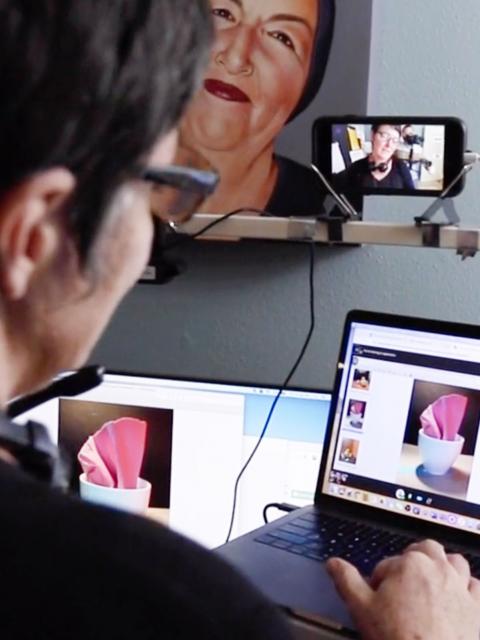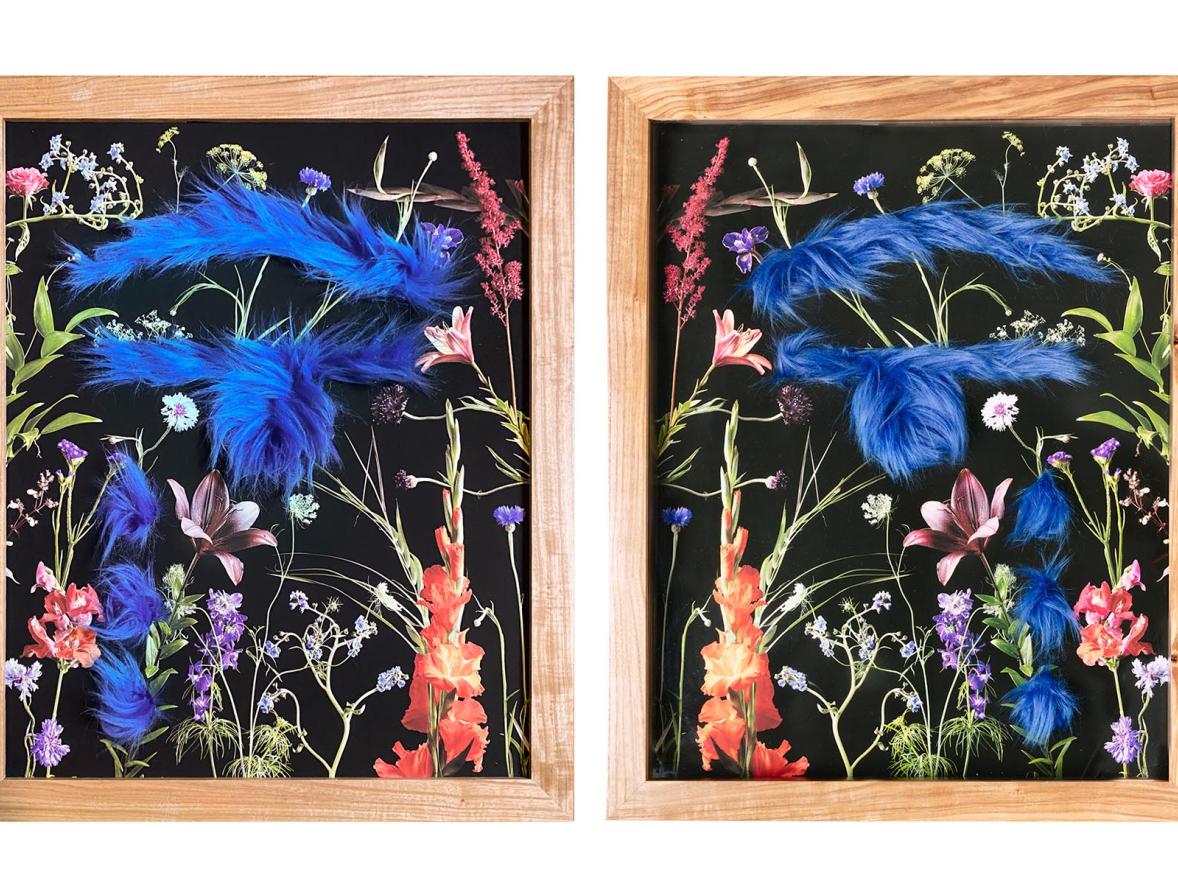Stroll up a garden path lined with purple coneflower and black-eyed Susan. Open an ocean blue door and follow the faint smell of paint down the hallway to a small stone-gray room filled with light.
Welcome to the remote teaching world of Professor Tamara Brantmeier.
Like all UW-Stout instructors, Brantmeier, of the art and art history department, prepared all summer to meet her students' needs for in-person and remote learning this fall.
As she searched for ways to adapt her Painting I, II and III classes, questions raced through her mind: What if campus buildings were forced to close because of COVID-19? What if her students were left without their still lifes, paints and canvases? What would her students need to have on hand to continue to create?
Brantmeier tried to think from her students’ perspectives. What she discovered was a way for her artists to bring their studio experiences with them wherever life leads them.
Redefining the teaching studio
Initially, Brantmeier felt both panic and positivity. Teaching remotely from her home in Menomonie, she knew she could adapt her teaching method to a COVID-19 world. But how?
Brantmeier has a home studio, but she needed a space where she could teach without distraction. So, she transformed her guest room into an office and teaching studio, complete with video cameras to connect with her students live through Canvas, the university’s online learning management system.
“Everything I needed to make happen to teach remotely would require new technology skills,” she said. “And I needed to be able to do it well to provide the best quality of instruction. It was a fast and furious learning curve.”
Brantmeier, not being tech-savvy, watched online teaching tutorials offered by the university’s Learning and Information Technology department and on Canvas. She found her best sources on social media. ArtProf.org offers instruction on how to teach art online, and Online Art & Design Studio Instruction in the Age of Social Distancing is a Facebook forum for art and design instructors.
With more than 16,000 members from across the U.S., “the forum is all about art and design instructors helping each other,” Brantmeier said. “You can post any question and have an answer in a couple of hours. That community saved us. I figured out how easy it is to make a video.”
An inspiring, new normal
Brantmeier is teaching two sections of Paining I, with 23 students in each section. And her combined section of Painting II and III has 20 advanced students. But with social distancing guidelines in place, the 1,200-square-foot Applied Arts Painting Studio can only accommodate a maximum of 11 students at a time.
So, while one-third of Brantmeier’s students are in the campus studio in the Applied Arts building over the course of a day, two-thirds are creating remotely.

Attending classes in person was not an option for seniors Rebecca Webster and Kayla Gullickson. Webster, a studio art major from Milaca, Minn., and Gullickson, an entertainment design major from Menomonie, are roommates and best friends. They made an at-home studio in the entryway of their apartment.
“I think that Professor Tamara has done an excellent job of adapting our class into an online learning environment,” Webster said. “This is my favorite class this semester for a reason. An online format is ideal for myself, as I am a strong, independent learner. And I have much more free time than I would if I was attending in-person classes, which has allowed me to have a better work/life/school balance than other semesters.”
With so many students creating remotely, and with the seemingly day-to-day changes of COVID-19, Brantmeier modified her assignments and requirements to better suit students’ immediate studio needs.
She used to require students to work on canvases as large as 24- by 30-inches. But this semester, students are using smaller canvases to work in smaller spaces, with the largest being 14- by 18-inches. She changed the supply list to have fewer paint colors to free up dollars so students could buy good lighting. And she extended deadlines to be flexible with students’ time as they’re adjusting to changes.
School of Art and Design Director Dave Beck said Brantmeier puts her students first in everything she does. “Her vision for this new normal is inspiring, and helps to remind us about the creative and unique culture we have in the School of Art and Design and at UW-Stout,” he said.
Connecting with her ‘painting babies’
Brantmeier begins every class with a poetry reading to inspire her students. And makes a point to tell them, “Your success is my priority.”

Brantmeier continues this mantra in her remote teaching. She wants her students to know she cares about them and their artwork, whether praising her “painting babies,” as she affectionately calls her first-year students, or strengthening community with advanced students.
At first, she feared the main strength of her teaching skills – her eye contact, her personality, her hand gestures – might be missing while teaching remotely. But she is determined to maintain a level of interpersonal communication to keep their connections strong.
“I’m good at drawing people in,” Brantmeier said. “I need to keep students drawn in in the online classes. So, the classes are always synchronous. My students see me. They see my creative process, my palette, my painting and what I’m painting. They’re able to see all of the elements of how to paint. And this is all a big part of how I connect with my students.”
Brantmeier records her live painting demos and uploads them onto Canvas, so students can rewatch the demos as needed and even pause the video while they’re painting.
“I also learned that students don’t need a perfect setting or background music,” she said. “They don’t care about perfection. They want realness. I can make a mistake and they know I’m the same person at home as I am in the classroom.”
"Tamara is a fearless teacher. We are lucky to have her thoughtful determination at Stout,” said Charles Lume, chair of the department.
Roving still lifes
Students in Brantmeier’s classes create still lifes and landscapes. She needed to devise a way for them to take their artwork and still life subjects with them wherever they decide to work. So, she created the “shoebox still life.”

“Students build a little environment with three objects, and they light it with an LED,” Brantmeier said. “It’s a controlled setup they can move around – a roving still life. They can have consistency with what they’re painting and flexibility to take it all with them. And it’s small, so it fits wherever they’re working, on campus or at home.”
Students will use their shoebox still lifes for two paintings; a classic observation and an abstraction and luminosity project. Soon, Brantmeier will critique the still lifes in the campus studio while students watch and listen from home. “I’ll feel like a live reporter,” she said.
Brantmeier plans to continue to make videos in the future, even when classes resume to being fully in-person.
“The videos will make the students’ learning experience stronger,” she said. “I’m really grateful for this experience. It’s forced me to learn new skills. And, as someone who overexplains things, I’ve had to be more concise and on point with my instruction.”
Looking ahead at new projects, she said, “I’m so in it right now. It’s really one day at a time, making videos on the fly. But I am glad to teach online. It feels consistent.”
The School of Art and Design offers seven fine arts programs, including a master’s in design.







